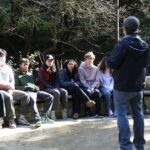On March 17, 2023, Gov. Gavin Newsom announced that the maximum-security San Quentin State Prison would be transformed into a rehabilitation facility focused on education to improve public safety. The $20 million plan, to be enacted by 2025, would introduce new practices borrowed from Norway’s carceral system to San Quentin.
San Quentin is California’s oldest and most infamous state prison — known for having housed many high-profile convicts and the largest death row population in the country. More recently, it’s been known to be the site of innovative prison education programs, now serving as a “nationwide evidence-backed model to advance a more effective justice system that builds safer communities,” according to a press release from Gov. Newsom’s office.
Opened in 1854, the prison was built when an increase in crime followed the Gold Rush. It was originally a private institution and subjected inmates to inhumane conditions such as floggings and “shower baths,” as well as convict-leasing. San Quentin has remained a site of violence throughout its history — it’s just one example of what occurs within prisons across the country.

photo courtesy of Wikimedia Commons
In the early 1970s, national prisons briefly implemented some rehabilitative practices. However, when American sociologist Robert Martinson released a study in 1974 describing his skepticism over rehabilitative programs, things changed. The study became widespread during the “War on Drugs,” which criminalized the public health issue of substance abuse primarily within working-class communities of color, beginning in the 1970s.
The prison population doubled during the War on Drugs and police and prison practices were militarized, disproportionately targeting communities of color. By the beginning of the 1980s, rehabilitation efforts were defunded in U.S. prisons and the prisons became increasingly plagued by violence, sexual assault and suicide.
The United States is a world leader in incarceration, holding almost 2 million individuals within its penitentiary systems. According to the Prison Policy Initiative, prisons might be secure, but they are largely unsafe. Violence is common in prisons, and is “tied to trauma prior to incarceration as well as mental health stressors inside.”
Today, San Quentin houses all death-row inmates in California. The death penalty has been in discussion for decades in California, being paused and reinstated several times since 1972. Although the lethal injection protocol was repealed by Gov. Newsom in 2019, there are still death-sentenced prisoners kept in a maximum security sector of San Quentin, effectively serving a life sentence.

photo courtesy of Wikimedia Commons
The 2019 order by Newsom also placed a moratorium on the death penalty in California. All people sentenced to death in California have been reprieved and the lethal injection facility at San Quentin will be closed as a part of the reform process.
The remaining San Quentin prisoners are primarily housed in medium or low security facilities. The level of security an inmate requires is based on an inmate number system — the lower the number, the lower the security protocol for that inmate. These numbers can change throughout a prisoner’s sentence based on their behavior and other factors.
The number system also determines if an inmate is allowed to enroll at Mount Tamalpais College (MTC). Formerly known as the Prison University Project, the associate’s degree program offers courses to incarcerated people at San Quentin. MTC’s core values include opportunity and access, excellence, independent critical thinking, respectful dialogue and human dignity.
Sydney Recht, a former English teacher at Lowell High School, now co-teaches an English class a few nights a week at MTC. “I believe firmly in restorative justice and the ability of education to help people change,” she said.
Austin Dannhaus is another teacher at MTC. Both Recht and Dannhaus described their students as incredibly engaged. However, there are some limitations to working with incarcerated people. “Students have pretty varied educational backgrounds, ranging from high school dropouts to some college experience. My English classes are typically the first stop for students,” Dannhaus said.
Despite the barriers that come along with teaching at a prison, Dannhaus feels able to host open discussions and teach freely. “We have honest and vulnerable conversations about the topics that we’re discussing. We do readings on really weighty topics about language, justice and power. We do some really great personal narrative work too,” he said. “From a content and engagement perspective, it’s an incredibly free and open exchange.”
In Lick-Wilmerding High School’s English 4 Honors: Carceral Culture, taught by Angela Wall, students look into the prison’s ideological function as an explanation for the cycles of violence perpetuated by the system.
According to Angela Davis in Are Prisons Obsolete?, prisons serve as an “abstract site into which undesirables are deposited, relieving us of the responsibility of thinking about the real issues afflicting those communities from which prisoners are drawn in such disproportionate numbers.” Wall strives to center her course around this quote.
Wall, who taught English at San Quentin for two and a half years, described the importance of education, whether it be opening up the doors for incarcerated people to get a degree or teaching the LWHS community about all the flaws in the carceral system. “The longer I teach, the more it seems to me that knowledge is power,” she said.
“San Quentin now has a lot of restorative practices, which is very unusual,” Wall said. “It exists in a very liberal pocket, lodged between UC Davis, UC Berkeley, Stanford, SF State and City College.”
Wall described an interfaith outreach program within the prison, which includes a lot of restorative justice practices that work to address the root causes of why people are there in the first place. “Volunteers can go in to lead healing sessions or Zen meditations, a lot of Buddhist practices,” she said.
Several outreach programs and projects, such as the Ear Hustle podcast and San Quentin News, have developed out of San Quentin, with the goal of giving incarcerated people a voice and putting real faces and stories to America’s understanding of the prison system.
The Ear Hustle podcast addresses issues that exist in the carceral system, from ending biased law enforcement practices, to restorative justice practices, to the process of reintegration into society. Many violent criminals have experienced physical and emotional trauma in their lives, resulting in mental health issues that prisons do not equip them to deal with.
As Davis points out, society is relieved from the responsibility of responding to mental health issues or violence inside prisons. This often results in inmates exiting no better off than they entered. According to the California Department of Corrections and Rehabilitation, California has a 60% recidivism rate within three years of release.
Recidivism is the tendency of a criminal to reoffend. Recidivism “clogs” the criminal justice system, as described by an article in the Harvard Political Review. The high recidivism rates in the United States demonstrate that “our prisons are as ineffective as they are inefficient, a sobering reality which calls for a reimagined criminal justice system.”
Norway, by contrast, has one of the lowest recidivism rates in the world. In the 1990s, the Norwegian prison system largely mirrored that of the United States — and the recidivism rates were similar. But the system was redesigned on the basic principle of prioritizing rehabilitation and integration, slashing recidivism rates by a factor of almost four. While American prisons are often viewed as a punishment, Norwegian prisons are often viewed as a preventative measure for future incidents.
Notably, the histories of the Norwegian and American carceral systems are very different. Norway is a much smaller country than the United States. Norway also does not have the legacy of slavery or Jim Crow that the American system was built upon, which made untangling and rebuilding the system much less complex.
Norwegian inmates consistently prepare for life after their release when inside prisons. In American prisons, inmates are kept behind bars until the day they are released. “These people, who are considered too dangerous even to leave a cell, become your neighbors,” Tom Eberhardt, Amend consultant, said regarding the current U.S. carceral system.
The life inside of Norwegian prisons is meant to resemble life outside as closely as possible. Inmates wear their own clothes, cook in communal kitchens, work, take classes and play sports. Their cells look like college dorms.
The security is dynamic — prison workers socialize and hang out with residents. They are trained to use force if necessary, but they also place equal emphasis on studying law, ethics, human rights and the science of behavior change. They learn that building positive relationships with those incarcerated helps them and reduces violence.
San Quentin is working its way towards this kind of dynamic between inmates and employees, but still has a ways to go. Recht feels comfortable and safe in her classroom and enjoys interactions with her students. However, she described an MTC policy that discourages her and the other volunteer teachers from sharing too many details about their personal life, which can sometimes create distance between her and the students.
The fact that earning a degree is accessible to prisoners at San Quentin is also a step forward, preparing inmates for life after prison just as Norway’s prisons strive to do on a greater scale. “Everyone in Norway will tell you: people go to court to be punished, they go to prison to become better neighbors,” Brie Williams, Co-Chair of the advisory group for San Quentin’s transformation, said.
Norway allows inmates to leave prison for a few days at a time, with the amount of time they are allowed to spend outside increasing as they get closer to their release date. This is intended to ease incarcerated individuals’ transition back into society.
The Ear Hustle podcast hosts interviewed Nina, an incarcerated individual in Norway, who reflected on her experiences with prison leaves. “I think in order to not feel like a prisoner, I have to not be a prisoner,” she said. “When I meet people, I’m afraid of their questions because I don’t know how to answer them.”
During her earlier leaves, Nina had trouble even finding words to answer very basic questions about herself, much less deal with more difficult interactions in day to day life. After she built up trust with the prison guards and began to reacclimate to normal life, she started to feel better about her release.
The American prison system, especially additional punishments such as solitary confinement, prevent prisoners from learning to deal with their emotions and interact with others in a healthy way. This causes formerly incarcerated individuals to be more likely to act out in a seemingly normal social situation, effectively making them more likely to be sent back to prison. The implementation of prison leaves such as those in Norway has been proven to help mitigate this issue.
In fact, many of the restorative practices that are to be implemented at San Quentin after its transformation to a rehabilitation facility will help prisoners to heal from their own trauma. These programs will help them understand how their trauma may have influenced their actions, the effects of their crimes on the victims and overall learn how to become a healthy contributor to society once released.
Not many details of San Quentin’s reform have been announced, but the plan is in discussion. “Today, we take the next step in our pursuit of true rehabilitation, justice and safer communities through this evidenced-backed investment, creating a new model for safety and justice — the California Model — that will lead the nation,” Gov. Newsom said.

photo courtesy of Wikimedia Commons
The American prison system currently perpetuates cycles of trauma, abuse and poverty. Ideally, funding would go to more preventative measures, such as public education, low-income housing and affordable, healthy produce. However, an equally important part of the equation is how prisons themselves can be used as preventative measures rather than simply punishment. Gov. Newsom’s proposal hopes to transform the infamous San Quentin Prison, once a site of harm for those incarcerated, into a place of healing.








Aviator Play Online https://www.aviator-game-bonus.com/
промокод Бетвиннер при регистрации на сегодня https://vsiknygy.net.ua/wp-content/pages/betwinner_promokod_2020.html
промокод Бетвиннер https://vsiknygy.net.ua/wp-content/pages/betwinner_promokod_2020.html
промокод Betwinner на сегодня бесплатно при регистрации https://vsiknygy.net.ua/wp-content/pages/betwinner_promokod_2020.html
Betwinner промокод https://vsiknygy.net.ua/wp-content/pages/betwinner_promokod_2020.html
промокод Мелбет http://greenpes.com/includes/pages/promokod_melbet_pri_registracii_2020.html
рабочий промокод Мелбет бонус https://mebel-3d.ru/libraries/news/?melbet_2020_promokod_dlya_registracii_besplatno.html
MelBet промокод на депозит http://greenpes.com/includes/pages/promokod_melbet_pri_registracii_2020.html
Мелбет промокод при регистрации http://greenpes.com/includes/pages/promokod_melbet_pri_registracii_2020.html
MelBet промокод на депозит https://mebel-3d.ru/libraries/news/?melbet_2020_promokod_dlya_registracii_besplatno.html
промокод Mel Bet http://greenpes.com/includes/pages/promokod_melbet_pri_registracii_2020.html
Pokerdom промокод бонус https://www.snabco.ru/fw/inc/promokod_pokerdom_oficialnuy_sayt.html
действующий промокод 1xbet http://lipetskregionsport.ru/news/pages/1hbet_promokod_na_6500_pri_registracii.html
промокод 1xbet на сегодня бесплатно при регистрации http://bashorg.org/images/pages/?promokod__260.html
1xbet промокод при регистрации на сегодня http://lipetskregionsport.ru/news/pages/1hbet_promokod_na_6500_pri_registracii.html
промокод 1xbet https://workme.net/wp-content/pgs/promokod__260.html
промокод 1x http://tdrimspb.ru/news/inc/1hbet_promokod_pri_registracii__bonus_do_32500_rub_.html
промокод 1хбет http://lipetskregionsport.ru/news/pages/1hbet_promokod_na_6500_pri_registracii.html
рабочий промокод 1xbet http://www.newlcn.com/pages/news/promokod_259.html
1xbet промокод при регистрации https://gravescare.com/tests/pgs/promokod_259.html
промокод 1хбет https://thecarving-board.com/wp-content/pages/promokod_260.html
промокод хбет http://lipetskregionsport.ru/news/pages/1hbet_promokod_na_6500_pri_registracii.html
промокод на 1xbet при регистрации https://rusgo.ru/wp-content/pages/1hbet_promokod_pri_registracii__bonus_do_32500_rub_.html
рабочий промокод 1хбет https://www.medtronik.ru/images/pages/1hbet_2021_promokod_pri_registracii.html
промокод 1хбет на сегодня http://braille.ru/wp-content/pgs/besplatnuy_promokod_pri_registracii.html
1хбет промокод http://www.solyaris.ru/imgbig/pages/?besplatnuy_promokod_pri_registracii.html
промокод на бонус 1xbet http://avernus.ru/demiurg/pages/1hbet_promokod_pri_registracii__bonus_do_32500_rub_.html
1xbet промокод на сегодня https://www.eltis.com/images/pgs/promokod_259.html
промокод при регистрации 1xbet на сегодня https://van-dekor.ru/img/pgs/?besplatnuy_promokod_pri_registracii.html
промокод 1x http://saratovturizm.ru/interesting/pages/promo_kod_bk_1xbet_na_segodnya_pri_registracii.html
промокод 1x https://reklamalubercy.ru/sites/pgs/besplatnuy_promokod_pri_registracii.html
промокод 1xbet при регистрации https://03ekb.ru/news/besplatnuy_promokod_pri_registracii.html
промокод 1xbet https://gravescare.com/tests/pgs/promokod_259.html
1хбет промокод http://balkonstroi.ru/incl_ude/pages/1hbet_promokod_pri_registracii__bonus_do_32500_rub_.html
промокод при регистрации 1xbet https://sansk.by/content/pag/promokod__260.html
промокод 1хбет https://www.jkfitness.com/wp-content/pags/promokod_260.html
1xbet промокод при регистрации https://crypto-mining.ru/wp-content/pgs/1hbet_promokod_pri_registracii__bonus_do_32500_rub_.html
промокод при регистрации 1xbet http://uzrf.ru/new2/pages/1hbet_promokod_pri_registracii__bonus_do_32500_rub_.html
1хбет промокод https://yct.su/terijoki/pages/promokod__260.html
промокод при регистрации 1xbet http://stickers.ru/articles/pages/1hbet_promokod_pri_registracii__bonus_do_32500_rub_.html
промокод 1xbet http://hammill.ru/pages/pgs/besplatnuy_promokod_pri_registracii.html
1хбет промокод https://oknador.by/wp-content/pgs/?promokod__260.html
1xbet промокод при регистрации на сегодня https://yct.su/terijoki/pages/promokod__260.html
промокод при регистрации 1xbet на сегодня http://hammill.ru/pages/pgs/besplatnuy_promokod_pri_registracii.html
промокод для 1 x bet http://www.medtronik.ru/images/pages/bonus_kod_na_1xbet_pri_registracii_6500_rubley.html